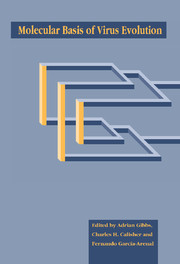Book contents
- Frontmatter
- Contents
- List of contributors
- Editors' preface
- Conference participants
- 1 Introduction and guide
- Part I The impact of viral diseases
- Part II Origins of viruses and their genes
- Part III Sources of virus variation
- Part IV Molecular interactions of viruses and their hosts
- Part V Viruses, hosts and populations
- Part VI Case studies of viral taxa; their systematics and evolution
- 18 Evolution of poxviruses and African swine fever virus
- 19 Molecular systematics of the flaviviruses and their relatives
- 20 Herpesviridae
- 21 Aphthovirus evolution
- 22 Evolution of the Bunyaviridae
- 23 Evolution of the tobamoviruses
- 24 The luteovirus supergroup: rampant recombination and persistent partnerships
- 25 The evolution of the Reoviridae
- 26 Genetic variation and evolution of satellite viruses and satellite RNAs
- 27 Molecular evolution of the retroid family
- 28 Adaptation of members of the Orthomyxoviridae family to transmission by ticks Patricia
- 29 The Order Mononegavirales: evolutionary relationships and mechanisms of variation
- 30 The molecular evolution of the human immunodeficiency viruses
- 31 Molecular evolution of papillomaviruses
- 32 Molecular systematics of the Potyviridae, the largest plant virus family
- 33 Evolution of alphaviruses
- 34 Evolution of influenza viruses: rapid evolution and stasis
- Part VII Techniques for viral systematics
- Index
21 - Aphthovirus evolution
Published online by Cambridge University Press: 04 May 2010
- Frontmatter
- Contents
- List of contributors
- Editors' preface
- Conference participants
- 1 Introduction and guide
- Part I The impact of viral diseases
- Part II Origins of viruses and their genes
- Part III Sources of virus variation
- Part IV Molecular interactions of viruses and their hosts
- Part V Viruses, hosts and populations
- Part VI Case studies of viral taxa; their systematics and evolution
- 18 Evolution of poxviruses and African swine fever virus
- 19 Molecular systematics of the flaviviruses and their relatives
- 20 Herpesviridae
- 21 Aphthovirus evolution
- 22 Evolution of the Bunyaviridae
- 23 Evolution of the tobamoviruses
- 24 The luteovirus supergroup: rampant recombination and persistent partnerships
- 25 The evolution of the Reoviridae
- 26 Genetic variation and evolution of satellite viruses and satellite RNAs
- 27 Molecular evolution of the retroid family
- 28 Adaptation of members of the Orthomyxoviridae family to transmission by ticks Patricia
- 29 The Order Mononegavirales: evolutionary relationships and mechanisms of variation
- 30 The molecular evolution of the human immunodeficiency viruses
- 31 Molecular evolution of papillomaviruses
- 32 Molecular systematics of the Potyviridae, the largest plant virus family
- 33 Evolution of alphaviruses
- 34 Evolution of influenza viruses: rapid evolution and stasis
- Part VII Techniques for viral systematics
- Index
Summary
Introduction
The Aphthovirus genus, family Picornaviridae, is composed of seven distinct serotypes which cause foot-and-mouth disease (FMD), a severe disease of cloven-hoofed animals. FMD has serious economic consequences (Pereira, 1981) and is enzootic in most South American and African countries, as well as in regions of Asia and the Middle East. Foot-and-mouth disease virus (FMDV) usually causes a systemic acute infection with high morbidity and low mortality (Shanan, 1962). In ruminants, the virus may also produce an asymptomatic, persistent infection that involves limited viral amplification (Van Bekkum et al., 1959). This type of infection has been proposed as an epidemiologically important reservoir of FMDV (Hedger & Condy, 1985).
The general structure and molecular features of FMDV are, in general, similar to those of other picornaviruses (Domingo et al., 1990; Stanway, 1990). The capsid is composed of 4 proteins (VP1-4) and includes an RNA molecule of about 8500 nucleotides in length which encodes the structural proteins and at least 11 different, mature, non-structural polypeptides. The antigenic structure of FMDV includes continuous and discontinuous neutralizing epitopes located in exposed regions of the viral capsid, in which one or more of the capsid proteins, particularly VP1, are involved (Domingo et al., 1990).
Aphthoviruses show considerable antigenic diversity; 7 serotypes, more than 65 subtypes and a multitude of variants have been identified mainly by in vitro cross-serum neutralization (Pereira, 1981) and, more recently, by the use of monoclonal antibodies (MAbs) (Domingo et al., 1990). Immunization with viruses of one type does not confer protection against viruses of other serotypes, whereas cross-protection within serotypes is not always complete (Kitching et al., 1989).
- Type
- Chapter
- Information
- Molecular Basis of Virus Evolution , pp. 310 - 320Publisher: Cambridge University PressPrint publication year: 1995
- 2
- Cited by



